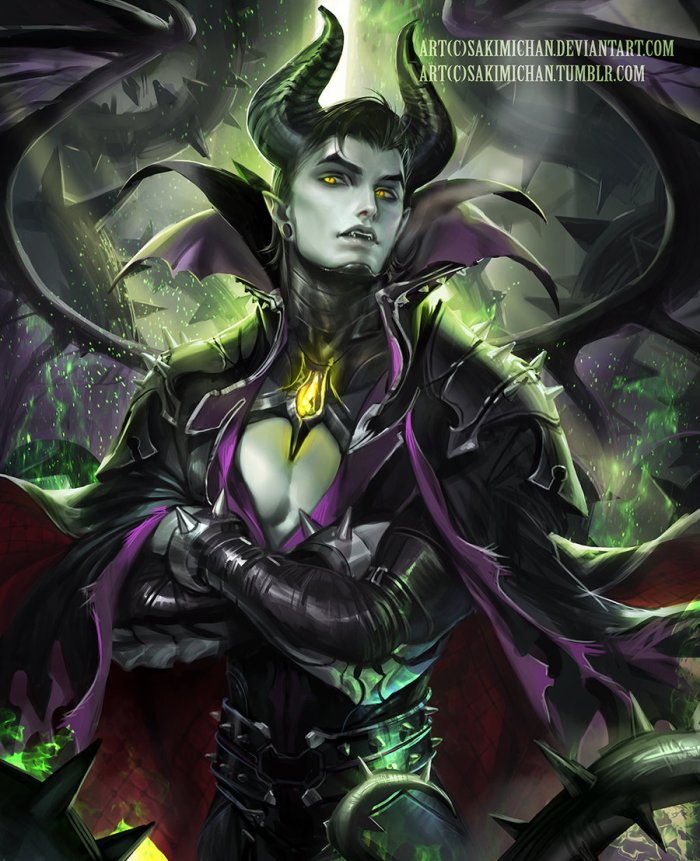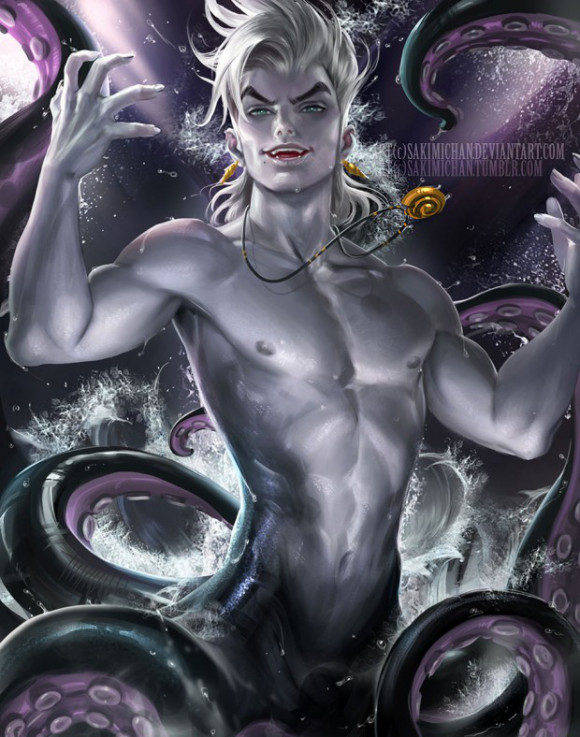By Derek Newman-Stille
Sakimichan is a Canadian artist who, among other things, creates beautiful gender-swopped fairy tale figures. We had a chance to meet briefly at Fan Expo Canada a few years ago. I had encountered her work before on Deviant Art and was impressed with her ability to challenge the firm gendered ideas of Fairy Tales produced by Disney.
Sakimichan challenges gendered boundaries and produces new ideas by swopping the genders of different characters.
Maleficent

This gender swopped Maleficent features the classic Maleficent horns and triangular collar from Disney’s Sleeping Beauty creation but this male Maleficent combines armour into his outfit.
He has a vampiric quality to his appearance with pointed canine teeth, pointed ears and yellow eyes. He has a tattered cloak and a kinky quality to his look with studded wrist bands and a studded collar and belt.
Sakimichan provides a classic “booby window” that is often part of superhero comic exploitations of women (featured in characters like PowerGirl). She simultaneously subverts the gendered construction of women as sexual objects by projecting these features onto male bodies while also revealing the implicit beauty in Disney’s original Maleficent with her classic cool green look, high cheekbones and powerful, curving brows.
Sakimichan infuses her image with Maleficent’s haughty arrogance and one can almost see this bad fairy yelling “fools” at all of us. The power of Maleficent’s pose is highlighted by his sweeping wings, the twist of thorny vines around his body and the sparkling of green fire highlighting his body.
Beauty and the Beast

Sakimichan’s Beauty and the Beast challenges the image of the male as a beast and woman as a demure, bookish figure who tolerates his oppression by switching their genders, opening up a new set of imagined possibilities. This Beauty plays with ideas of gendered movement by portraying a man with a sweeping neckline, curving his neck and looking up romantically at his lover, eyebrows raised and lips parted. The femininity of Beauty’s pose illustrates the potential for gender blurrings.
Sakimichan’s Beast is wrapped around her beauty, showing her awkwardness by adjusting the hair around her face. She has a thicker frame and stronger musculature to illustrate her protective pose.
Lumiere in the background illustrates the feminine potential of a candlestick, with a curving of her hip and generous wax lips. This Lumiere follows the Disney version’s exuberance of movement and performative quality.
Little Mermaid

Sakimichan’s Little Mermaid captures the innocence of Disney’s Little Mermaid image with wide eyes, a slightly opened mouth and raised eyebrows. This Ariel’s sweeping hair ties in with the burst of waves surrounding him, both feathering out at the edges.
Sakimichan makes reference to the Disney film by showing a fork tied to the Merman’s bicep. The fork is tied on with seaweed, allowing the Merman to seem tied to his ocean environment even though he desires a life above the waves. This is a Merman who wants to connect to the world of wonder and newness above, but also wants to anchor himself in the world beneath the sea.
Flounder is feminised in this image by having a flower in her dorsal fin. Flounder’s femininity is captured by her eyelashes and the hair-like quality of her dorsal fin.
Sakimichan captures movement and a sense of wonder in her take of the Little Mermaid, the bridging of worlds of life above and below the waves, but also bridging the gendered binaries inherent in most fairy tales.
Ursula

Sakimichan didn’t end her Little Mermaid art at Ariel and her take on the Ursula infuses elements of Ariel’s painting into this villainous world. Ursula is surrounded by a movement of waves, but instead of being at the surface, this Ursula is stirring up bubbles in the deep.
Ursula’s tentacles writhe about his body, accentuating his musculature as well as his fluidity and connection to the depths of the ocean.
Although Disney’s Ursula is fat – which is problematic itself by portraying only the villain as fat – the muscular appearance of this male Ursula represents a quality of fat-erasure, assuming that only muscularity is attractive.
This Ursula is darkly attractive like Sakimichan’s Maleficent with arching brows, pointed ears and sharp canines. There is similarly a vampiric quality to this figure and the alabaster look to his skin emphasises the dark potential of this body.
Sakimichan’s gender-bent figures illustrate the fluid gender possibilities of fairy tale rewritings. These figures bring attention to the way that gendered behaviours have been encoded in our fairy tales, and also point to a way to imagine gender otherwise.
You can check out Sakimichan’s work at her Deviant Art site at http://sakimichan.deviantart.com/gallery/
Reblogged this on Over the Rainbow: Folk and Fairy Tales from the Margins and commented:
If you are interested in some inspiration about gender play in fairy tales, check out this discussion of the art work of Canadian artist Sakimichan.
LikeLike